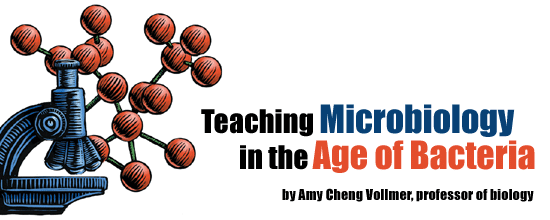Teaching Microbiology in the Age of Bacteria
 |
"It's not what we say..." How would you complete this statement? I can think of three ways:
Can you think of another way to complete the statement? This illustrates one important point in our profession - there is often more than one 'right answer,' because students (and teachers) approach topics from varied perspectives, informed by their own experiences and their own ways of learning. People can take away very different messages from the same presentation. I often find myself asking students, "Can you see it or explain it in a different way?" Relating an abstract topic to an aspect of their own lives creates a learning atmosphere by which students become "owners" rather than "renters" of knowledge. Here we are at a time when our textbooks and other resources are growing in volume, but the time that we have in the academic term is still limited to 10-14 weeks. How, then, are we to give an historical perspective, bring our lectures up to date, and cover so much material? It is a daunting task, and can certainly seem overwhelming. What if the topics I choose to omit are part of the MCAT or some of the general assessment? How can I prepare students for a future that we cannot predict? It's not what we say, it's what we doStudents, like our children, are watching us: at the bench (designing, executing and analyzing experiments, following and cleaning up), as scholars (writing, proofreading, citing sources, presenting, discussing, not procrastinating, honoring deadlines), as colleagues (in service to our professional communities), and as humans (being dependable, not over-committed, adapting to change, setting, and adhering to priorities). We are role models - inside and outside of the classroom! It's not what we say, it's what we don't sayWhen I began my career as an assistant professor of biology at Mills College, a wonderful senior colleague, Darl Bowers, shared a bit of wisdom with me. He said simply: " The most important decision we make as teacher is what to leave out!" Little did I know what he really meant by that statement. We face a challenge and a privilege:
It is liberating to accept that we can't "cover" it all! By acknowledging our limitations, we relinquish control of exactly where the course is headed. Rather, we concentrate on establishing a foundation for our students, giving them a sense of the landscape and encouraging them to learn and think for themselves by supporting intellectual risk-taking and helping them overcome their fear of failure. It's not what we say, it's how we say itWe need to continue to keep our knowledge current, hone our own techniques both in the laboratory and classroom, and apply the same strategies to teaching that we do in research - get advice when things aren't working well, try new techniques, adapt methods that others have developed for our own applications, and communicate our findings with others. In my teaching, I am working on two new projects.
I have invited non-science Swarthmore faculty members to spend a month in my laboratory. Last summer, Philip Jefferson from economics and Cheryl Grood from mathematics and statistics joined me to work on constructing a couple of new strains and enumerating antibiotic resistant bacteria from various campus locales. We learned a great deal from each other about communication and critique of the process by which scientific work is done. We read magazine articles and discussed many topics about how microbiology impacts society. Philip wrote an article about his experience that was published last October in The Chronicle of Higher Education. Next summer, two more colleagues, one from engineering and one from music, will be joining me.
How then, do we resurrect this area of the curriculum? Most people find the subject dry and boring, like reading maps. So why does one study a map? To get to an interesting destination. Hence the Tour Guide will contain a compilation of interesting metabolic destinations - molecules and enzymes that have intriguing properties. I have asked colleagues to send me their favorite destinations so that I can work them into pedagogically useful stories or case studies. By suggesting these destinations, I hope that we can encourage students and their teachers to explore the pathways that lead in those directions. I invite anyone in the audience to send me their favorite destination. I will be sure to properly attribute all contributions!
|
|||||||||||||||||||






